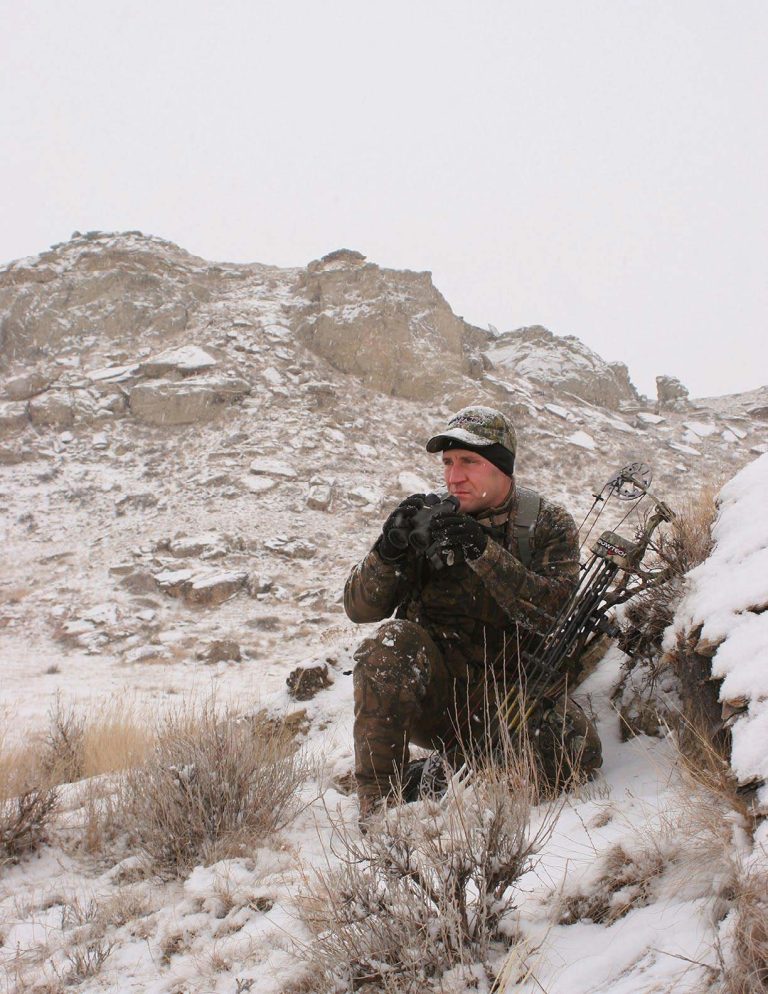The anticipation regarding a Wyoming Whitetail deer hunt began a year earlier, after filling a mule deer tag in the same area. Once the mule deer hunt came to a close earlier than planned, I had the pleasure of exploring the land there and what I saw left me wanting more.
When I think of exceptional Whitetail deer destinations, the northeast corner of Wyoming doesn’t initially come to mind. But what I saw after taking a double drop-tine mule deer in the area left an impression that I would not be able to shake until the next time I hunted there 12 months later.
Seeing more than 100 Whitetails grazing out of the timber in the evening left no question as to the density of deer in the area. The number and size of bucks also caught my eye.
“We don’t take many bucks out of here during the course of a season,” smiled Guy Howell, owner of Center of The Nation Outfitters in Colony, Wyoming. “And what deer we do take are usually mature ones.”
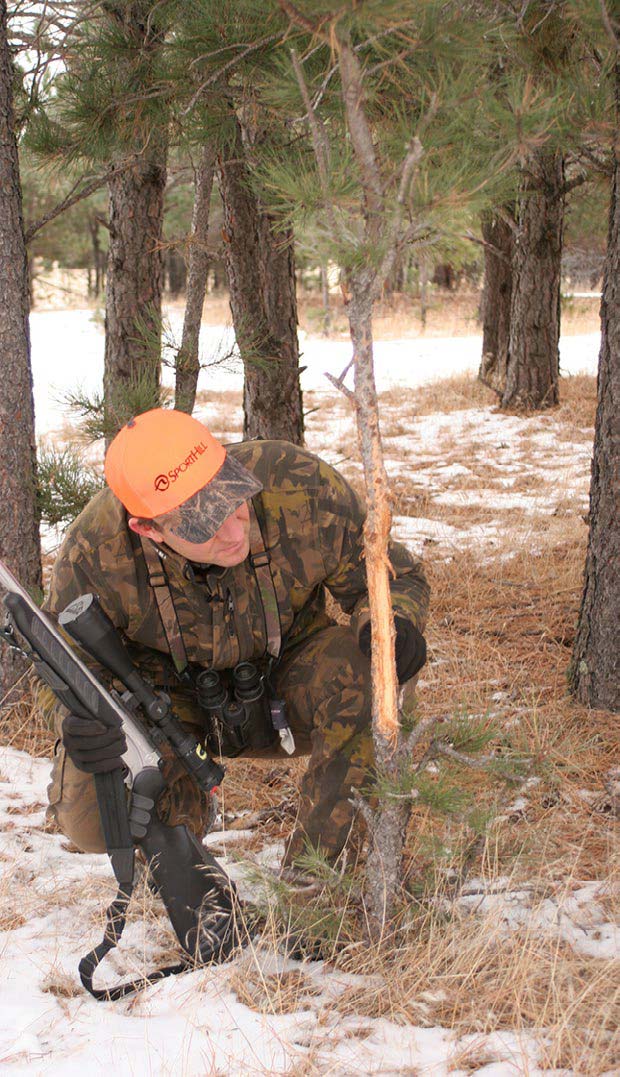
Whitetail Adventure
The tough part about holding the tag I drew for this part of Wyoming is that either a mule deer or Whitetail can be taken with it. The fact that Howell had seen a mule deer approaching the 190-inch class didn’t help keep my focus on Whitetails.
For two days, we searched for that big 4×4 muley buck. An intense wind storm interspersed with snow drove all the mule deer in the area into hiding, though. We made the choice to go back to Whitetails as originally planned.
That evening we found ourselves in a ground blind looking for two specific Whitetail bucks. “There’s a high, heavy 10-pointer hanging out in this area, as well as an impressive 18-point, which is non-typical; that’s how many points I counted on his rack the other day,” said Howell.
Prior to my arrival, one of Howell’s clients had missed a crack at the big non-typical, and though the buck wasn’t hit, Guy had not seen it since.
Howell figured the 10-point buck would go into the 160-inch class. After seeing deer of that caliber a year earlier, I didn’t question his usually conservative estimate. But that buck hadn’t been seen for a while.
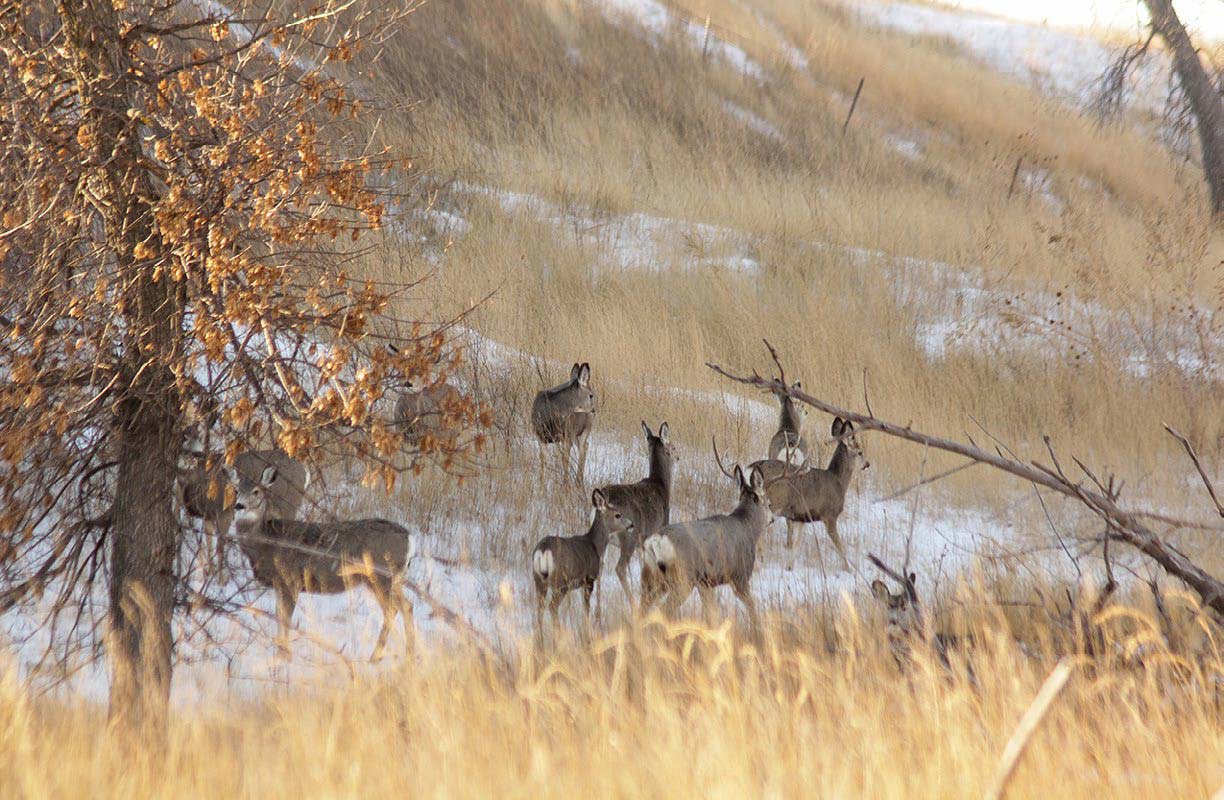
Given the series of storms that swept through the area in the past two weeks, and the fact I was the last hunter of the season, the chances of finding either of the mature bucks seemed grim.
As if catching a glimpse of a smart, nocturnal whitetail buck isn’t hard enough, I knew going in that this late in the season, the odds were stacked against us. One plus was that many of the bucks there were still acting rutty. Though the chasing we’d been seeing was largely being done by lesser bucks, seeing that there were still some receptive does kept our level of optimism high.
But after three days and no sign of either of the big bucks, and only one day remaining in the season, it was crunch time. Each morning and evening we had sat or stalked the timber patch where the big bucks were last seen, but they eluded us.
“The bucks may have left the area,” noted Howell. “With the number of scattered does still coming into heat and the number of new bucks moving into this area each day, it wouldn’t surprise me if those big bucks are gone. And with one day of hunting left, well, it’s your call.”
The final morning found us again, walking through the crusted snow at timber’s edge, searching for a big Whitetail. After looking at more than two dozen bucks, one finally caught Guy’s attention.
This buck was first chasing a doe, then he’d lose interest and go to feeding. The pair had just emerged from the bottom of a grassy draw and the buck was focused enough on the doe that an open-country stalk was possible.
We had 150 yards of wide-open space to trek before reaching a comfortable shooting position and the knee-high grass was far from capable of covering our movement. Fortunately, the wind was in our favor. Every time the deer dropped their heads or faced away, we inched forward.
After what seemed like an eternity, we finally reached an old fencerow and about as close as we could get. . Slipping a Remington 180-grain Swift Scirocco cartridge into the .300 Winchester Magnum, all felt steady. The buck had its head down and was feeding away at 230 yards. All I needed was for the buck to turn slightly to the side to expose its vitals.
As the doe moved away, the buck raised its head and followed. Through the 3×9 Trijicon AccuPoint scope I could clearly see the high, 10-point rack. The Whitetail wasn’t as big as some bucks we’d seen, but it was in a good position and I wanted to take some great eating meat home to the family.
The buck stopped at 240 yards ande slightly quartered away. At the shot, it jumped, ran a few yards, then collapsed. It was a nice, clean kill, and it turns out, some of the best venison to be found.
After taking care of the Whitetail buck I loaded it into the truck and headed to South Dakota. I passed through the quaint town of Buffalo, and on to the ranch of Reese Clarkson of Mill Iron Outfitters.
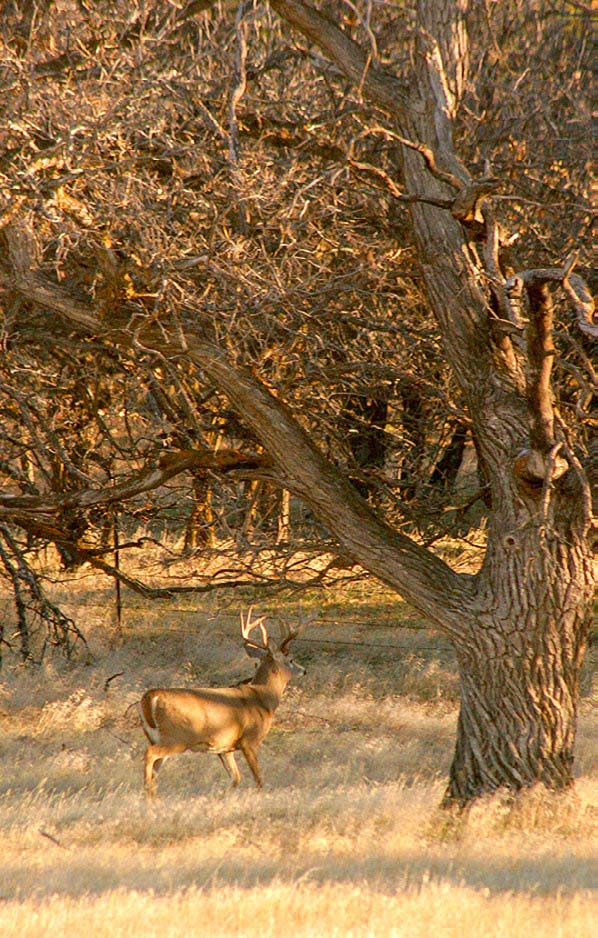
Bowhunting Mule Deer
I’d hunted pronghorn and mule deer before with Clarkson, so I knew the area. As night fell, a quick look around part of Clarkson’s vast land left us a bit concerned.. The same storm that hit Wyoming had also blasted through this portion of South Dakota, and many deer were gone. How far away they went was anyone’s guess. Given the labyrinth of cuts, draws, gullies and ravines to hide in here, there was no telling where they were.
The next morning we moved to a knoll, greeting a stunning sunrise in 13º -below-zero temperatures. We spotted some mule deer through the spotting scope. Their white, frost-covered backs glistened in the growing light, however, no good bucks could be found.
The next high point found us looking into a timbered draw. It was a spot Clarkson had seen a high-racked 4×4 buck a few days earlier. “The last time I saw him he was with nine does right on that hillside,” Clarkson said. “Given the bad weather we’ve had, I bet he held tight in the tree belt.”
As we continued glassing the trees and connecting ravines, I reflected on the many exciting hunts Clarkson and I had shared on his place over the past few seasons. A year earlier, on Halloween day, I stalked to within 17 yards of a 29-inch wide four-point mule deer buck and slipped an arrow into it. Before that, I took my biggest pronghorn to date with a rifle. I also took another record-book buck with a bow.
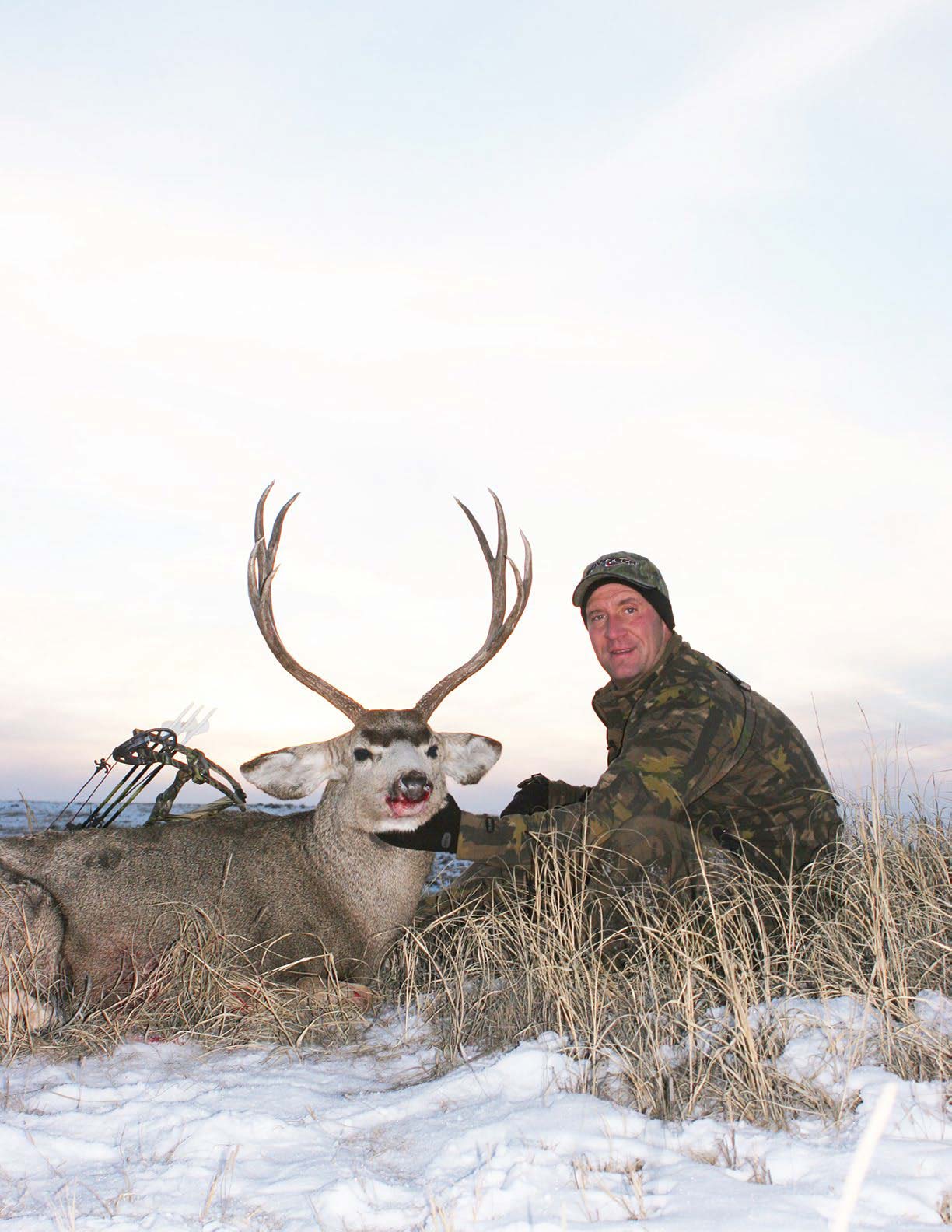
“There he is,” whispered Clarkson, snapping me out of a daze. I was so deep in thought that I failed to notice the cold slime trail running from my nose to my upper lip. My jaw muscles were tight from the freeze, making it hard to talk. Thankfully no words were needed, for I picked up on the buck as it moved out of the bottom of a draw, complete with nine does.
“As soon as they drop into that next draw, you can make your move,” encouraged Clarkson. Soon the group was out of sight and I was on my way. A skiff of snow covered the ground, but it was frozen solid and made for noisy going in the still, crisp air. Just as I got ready to plunge into the draw hoping for taller grass to muffle my sound, the deer emerged on the opposite hillside. They were less than 100 yards away. They had bedded there with the morning sun hitting them. The buck was in the middle. Since I had a bow, there was no getting within range.
I backed out, joined Clarkson, and we got out of there, giving the deer space. Six hours later, having found no other bucks, we returned. Two hundred yards from where we last saw the deer, we found our 4×4.
The buck was bedded next to a single doe. The rest of the herd was spread out amid the trees, feeding. Playing the wind, I figured I could slip into a creek bottom, up the backside of the knoll where it was bedded, and maybe get within bow range.
The second I set foot in the bottom of the gully, I told myself it wasn’t going to happen. The snow and leaves were so crunchy I knew the deer would bust me. But I pushed on as darkness approached.
As slowly and as quietly as possible, I pushed forward and found myself beneath a tree I’d marked as in direct line with the bedded deer. I was about 80 yards from them. The crest of the knoll stood between us. My only option was to walk straight toward the buck and doe, hoping they’d still be bedded.
Three steps into it, two does spooked from the trees below me. They ran out in front, and I was sure they’d spook the buck. Five minutes later, still battling crunchy snow, I could see the two deer I’d jumped. They were standing on the opposite hillside looking back at me.
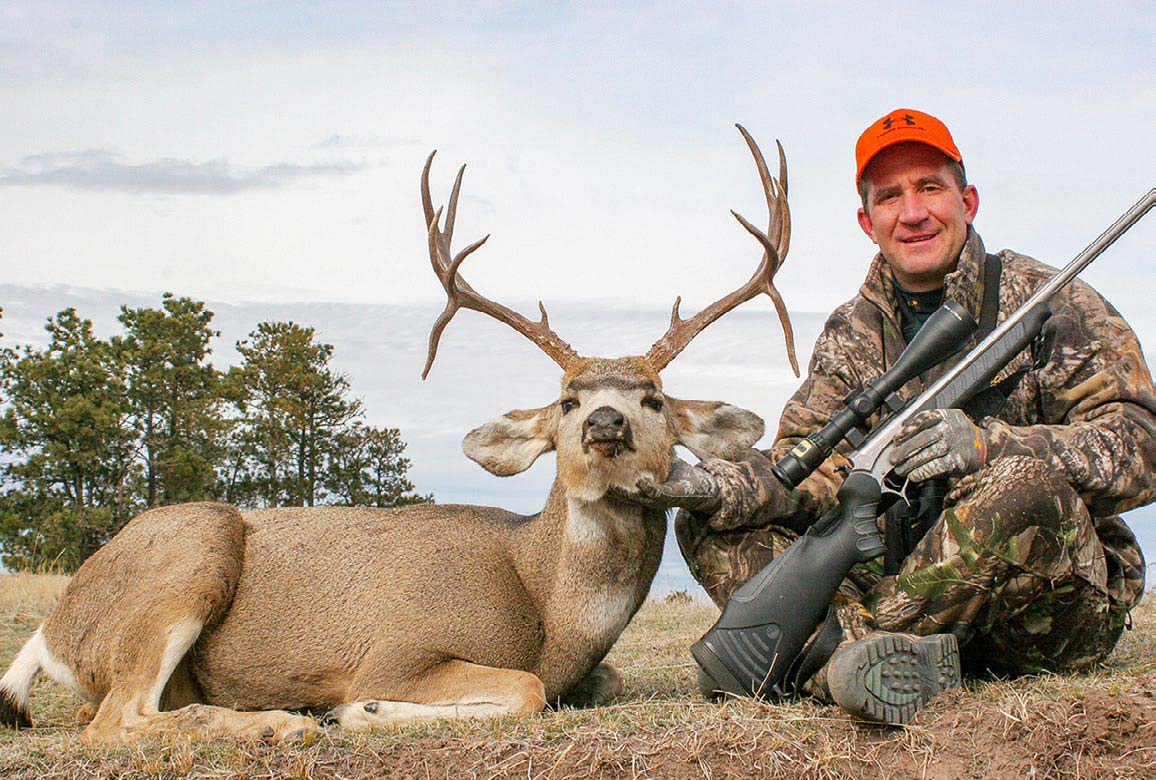
Tediously picking my way forward, I finally saw the tips of the big buck’s rack. It was still bedded. Given its position, there was no shot opportunity. I had no choice but to wait for the buck to stand and hope for a shot.
Daylight was coming quickly and the now 8º temperatures, combined with a breeze, took the windchill to below zero. The question nowwas, who would give in first?
Just then, the doe that was bedded with the buck stood up and started prancing right for me. The other two nervous does spooked the bedded one in my direction. I quickly drew my bow and stayed stone-still, and on my knees. The doe had no idea I was there and kept coming, with the buck now on her tail.
At 12 yards, the doe saw me, but didn’t spook. The buck got to within 20 yards and I grunted to stop it, but it was so focused on the doe it paid no attention to me.
The buck stuck with the doe, and they were still on the move. They dropped out of sight behind some sage and I let down on the bow. Then they emerged 40 yards away. The doe finally stopped and looked back. The buck paused right behind her, still within bow range.
The cold temperatures didn’t phase me, surprisingly, as I reached full draw. Slight pressure on my release sent the arrow on its way and into the chest of the buck. The recovery was quick.
By now, it was below zero as the sun plunged beneath the horizon, but the harsh conditions only added to the memories of the hunt. It took me back to the days I lived and hunted in the Alaskan Arctic. Then, snow covered the ground nine months of the year and below zero temperatures were the norm for more than 200 days.
In two states, two good friends managed to work as a team to tag two deer in two consecutive days. At times like this, I think the good old days of deer hunting the American West are still upon us.
Note: For signed copies of Scott Haugen’s popular line of hunting books, visit scotthaugen.com. Follow Scott’s adventures on Instagram and Facebook.
Per our affiliate disclosure, we may earn revenue from the products available on this page. To learn more about how we test gear, click here.



